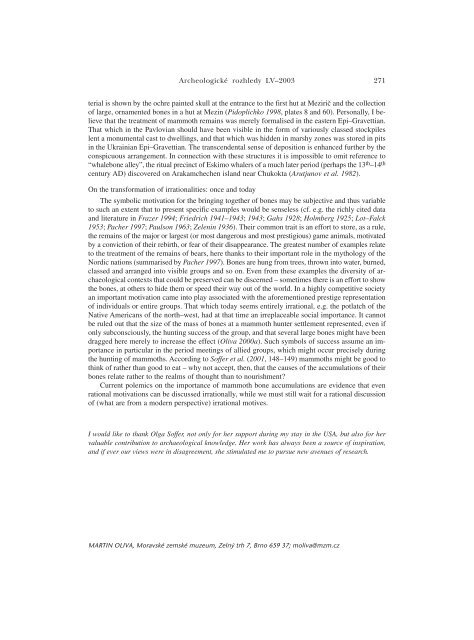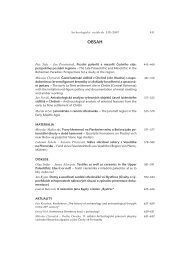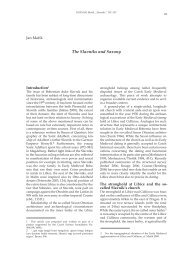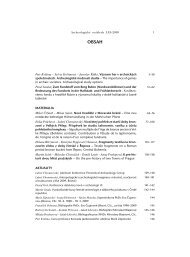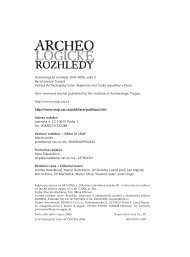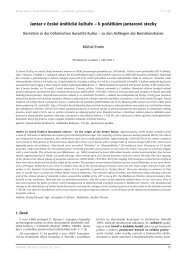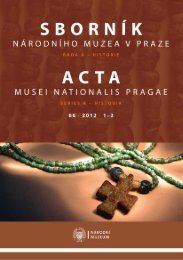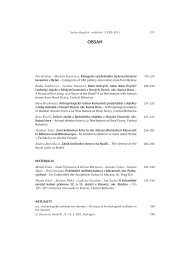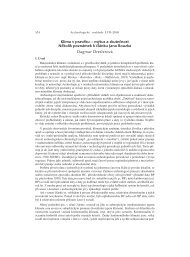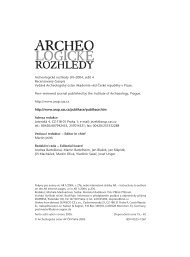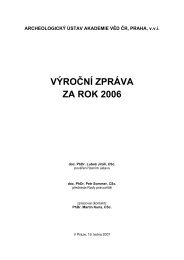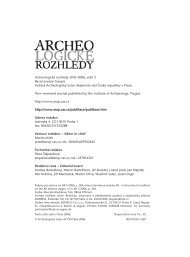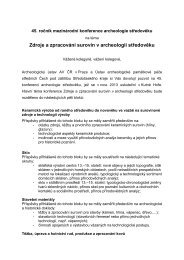270OLIVA: K v˘znamu akumulací mamutích kostí ...were found in the Aurignacian layers (Münzel et al. 1994, 87). A large concentration of mammothbones (skull, mandible, shoulder blades, tusks) was uncovered by G. Riek (1933, 156–157; 1934,53–54) in the Lower Aurignacian layers at the entrance to the Vogelherd cave. From numerous otherexamples it can be shown that almost everywhere that mammoth bones appear with artefacts theselection of these bones is, from the practical point of view (as food, fuel, raw material or buildingmaterial) inexplicable. The proportion of large, non–meaty bones does not even change with sitelocation, vis–à–vis possible kill or collection sites – they appear at various distances from river valleys,at various relative heights, in the open air and in caves. Sites with a rational representation of bonesfrom the butchery point of view (where only vertebrae, ribs or parts of the limbs and autopodia) arealmost unknown.On the evidence of ritual use of mammoth bonesPavlovian burials in Moravia provide clear evidence of the use of large bones in connection withrituals (Dolní Věstonice I /3 and 4, Pavlov I/1, Brno 2, secondary deposition of bones at Předmostí,summary in Oliva 2002). At Kostěnki on the Don mammoth bones accompany 3 of the 4 burials.The telling finds context at Weinberghöhle cave near Mauern in Bavaria was described by A. Bohmers(1951); next to the walls lay spinal pieces from 6 young mammoths, and further back a wholeskull, tusks and shoulder–blades. Everything had been covered in red ochre and was accompaniedby small mammoth ivory beads and a large quantity of stone tools.A similar symbolic dimension is undoubtedly hidden in the various types of structures hithertoassumed – because of their possible practical function – to have been purely practical. This applies inparticular to the so–called “meat caches” of the Ukrainian Epigravettian. Early on, I. G. Šovkopljas(1972, 179) argued that the pits at Dobranichevka are so tightly packed together that there was nospace for the meat. A similar case occurred at Mezin (Šovkopljas 1965, 89), and the opinion thus arosethat the pits served as stores for raw material, fuel and among some, even from the start, for thedeposition of waste (Soffer 1985, 255, 461; Soffer et al. 1997). The practical functions given, however,raise similar questions to the masses of remains on the surface. The storing of bone fuel in pitshas no analogy, and is not supported by the preponderance of impractical large bones, such as thepelvis, shoulder–blades, skulls, lower jaws and tusks. These could perhaps have been used ratheras alternative building materials (but then why hide it in pits, where it is not to hand?), but only withdifficulty as a raw material. Tusks are very abundant in pits, even if mammoth ivory was almost unworkedat some settlements (e.g. Dobranichevka). The sinking of pits into frozen ground for thepurpose of depositing minor waste need not be seriously considered, perhaps. The rationality of thisview, however, does not rest on its likelihood but on its expedience: for O. Soffer it was sensible topreserve the idea originally proposed by Jefimenko, that these were rather pantries, because shewished to show how the shift of pits from the middle of the settlement to several of the huts reflectsthe gradual poaching of resources by an emerging elite (Soffer 1985, 462). Further, every pit containsin addition to the dominant large bones other items as well, such as ossicles from small or tinyanimals, often very numerous stone tools (at Mezin 2278 pcs), fragments of bone tools and weapons,ochre etc. Six of the 13 pits at Mezin also contained Tertiary molluscs (up to 51 pcs) and 3 the fragmentsof works of art too (Sergin 1987, table 2). The cited table also provides an overview of therepresentation of individuals mammoth bones: in all, there were 13 skulls, at least 20 mandibles,a minimum of 39 tusks, 25 shoulder–blades, 26 pelvises etc., while against this there were only about34 rib fragments and around a hundred vertebrae. It is characteristic of practitioners of contemporaryPalaeolithic archaeology that they interpret meat storage pits according to that which has never beenfound within them; if this is a purely utilitarian issue, the lack of sufficient matching finds and moreprecise analogies seems not to worry them. Even if the pits originally had a practical function, thedrawing together of large bones with ash, ochre and various artefacts testifies that at least in theirfinal phase they related to a particular treatment of mammoth remains.Along with the pits, stable huts of mammoth bone, often monumental in scale (Mezin, Mezirič,Judinovo etc.) also appear. That the mammoth remains here did not represent only a building ma-
Archeologické rozhledy LV–<strong>2003</strong> 271terial is shown by the ochre painted skull at the entrance to the first hut at Mezirič and the collectionof large, ornamented bones in a hut at Mezin (Pidoplichko 1998, plates 8 and 60). Personally, I believethat the treatment of mammoth remains was merely formalised in the eastern Epi–Gravettian.That which in the Pavlovian should have been visible in the form of variously classed stockpileslent a monumental cast to dwellings, and that which was hidden in marshy zones was stored in pitsin the Ukrainian Epi–Gravettian. The transcendental sense of deposition is enhanced further by theconspicuous arrangement. In connection with these structures it is impossible to omit reference to“whalebone alley”, the ritual precinct of Eskimo whalers of a much later period (perhaps the 13 th –14 thcentury AD) discovered on Arakamchechen island near Chukokta (Arutjunov et al. 1982).On the transformation of irrationalities: once and todayThe symbolic motivation for the bringing together of bones may be subjective and thus variableto such an extent that to present specific examples would be senseless (cf. e.g. the richly cited dataand literature in Frazer 1994; Friedrich 1941–1943; 1943; Gahs 1928; Holmberg 1925; Lot–Falck1953; Pacher 1997; Paulson 1963; Zelenin 1936). Their common trait is an effort to store, as a rule,the remains of the major or largest (or most dangerous and most prestigious) game animals, motivatedby a conviction of their rebirth, or fear of their disappearance. The greatest number of examples relateto the treatment of the remains of bears, here thanks to their important role in the mythology of theNordic nations (summarised by Pacher 1997). Bones are hung from trees, thrown into water, burned,classed and arranged into visible groups and so on. Even from these examples the diversity of archaeologicalcontexts that could be preserved can be discerned – sometimes there is an effort to showthe bones, at others to hide them or speed their way out of the world. In a highly competitive societyan important motivation came into play associated with the aforementioned prestige representationof individuals or entire groups. That which today seems entirely irrational, e.g. the potlatch of theNative Americans of the north–west, had at that time an irreplaceable social importance. It cannotbe ruled out that the size of the mass of bones at a mammoth hunter settlement represented, even ifonly subconsciously, the hunting success of the group, and that several large bones might have beendragged here merely to increase the effect (Oliva 2000a). Such symbols of success assume an importancein particular in the period meetings of allied groups, which might occur precisely duringthe hunting of mammoths. According to Soffer et al. (2001, 148–149) mammoths might be good tothink of rather than good to eat – why not accept, then, that the causes of the accumulations of theirbones relate rather to the realms of thought than to nourishment?Current polemics on the importance of mammoth bone accumulations are evidence that evenrational motivations can be discussed irrationally, while we must still wait for a rational discussionof (what are from a modern perspective) irrational motives.I would like to thank Olga Soffer, not only for her support during my stay in the USA, but also for hervaluable contribution to archaeological knowledge. Her work has always been a source of inspiration,and if ever our views were in disagreement, she stimulated me to pursue new avenues of research.MARTIN OLIVA, Moravské zemské muzeum, Zelný trh 7, Brno 659 37; moliva@mzm.cz


